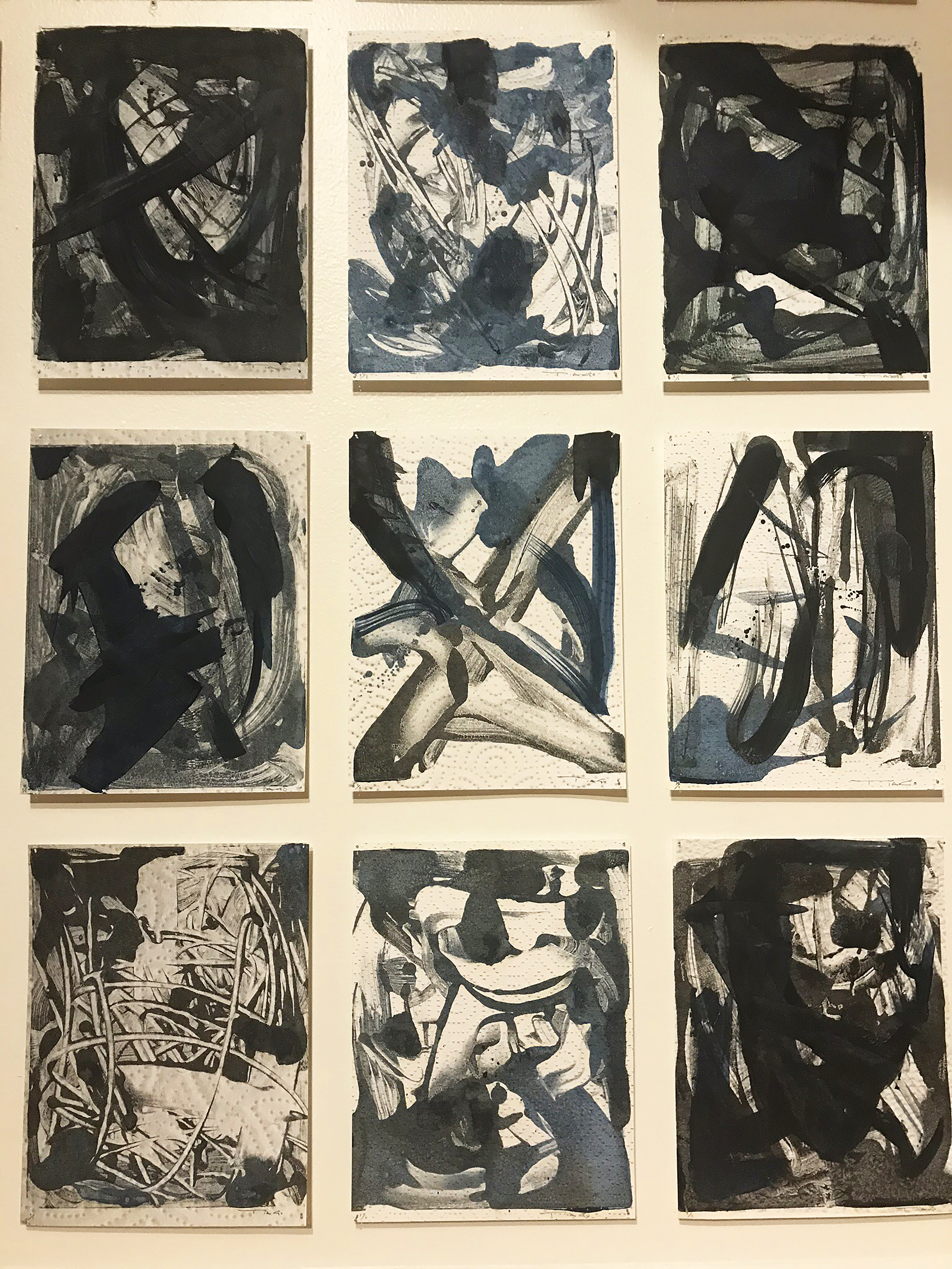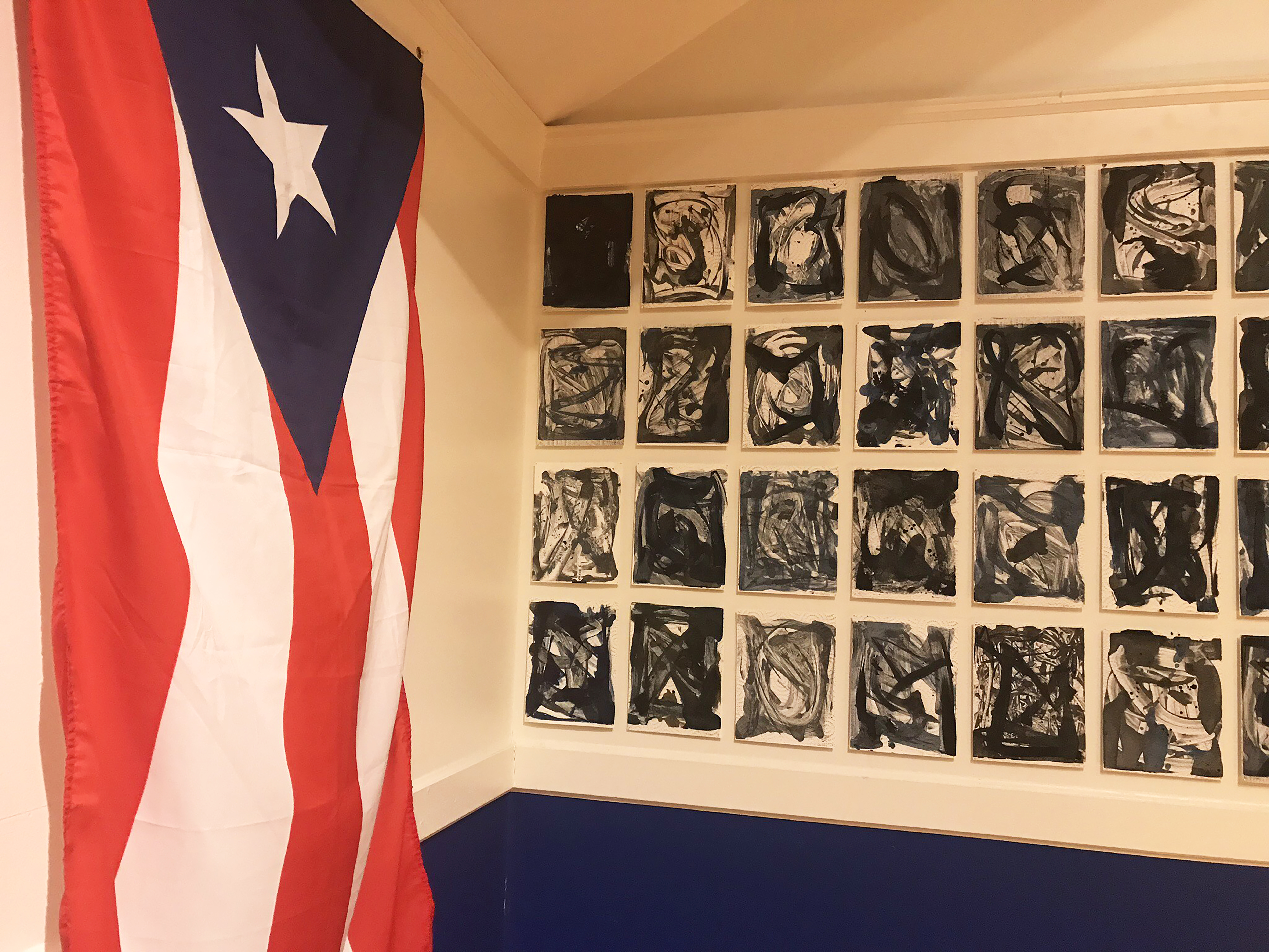On Oct. 26, Puerto Rican artist Tiago delivered a gallery talk during the installation of his art exhibition “The Frailty of Strength and vice-versa” in Unity House’s Pepsico room.
On the wall, 130 monotype paintings hung in neat rows. They were all the same size, a little larger than a piece of A5 paper, painted with muted blues, reds, greys, and purples. The paintings were abstract action pieces that, as Tiago later explained, he created by expressing his feelings at the present moment through painting onto a piece of glass, then transfering that painting onto a uniform piece of paper. Therefore, each is unique and cannot be replicated. As Tiago spoke, he continued to mount his pieces as a form of performance art to accompany his exhibition.
Sporting a baseball cap and Star Wars t-shirt, Richard Santiago– known as Tiago in the art world–exudes a relaxed energy, which makes his lecture much more accessible. In fact, accessibility is one of things he is passionate about, especially after losing his art studio and many of his pieces, during Hurricane Maria. “There’s a whole market out there that makes it really hard for us to paint,” Tiago said. “And so, I felt that [losing my materials] was not an excuse not to do something. I made a point to use the least amount of equipment possible to [make] this.” Additionally, in order to ease traveling and transportation costs, he wanted the pieces to be small instead of using huge canvases. As a result, each piece can easily fit into a binder that can be brought onto a plane in his carry-on. Tiago, as an artist and as a person, emphasizes accessibility, not only through being cost effective, but also through rejecting the pretentious attitude that the art world can promote. The lecture, too, was casual. As Tiago continued to mount his pieces, he invited us to grab some food, traditional Puerto Rican food like rice and beans and plantains, before he began speaking.
Throughout the lecture, Tiago focused not only on his art process and the collection’s significance but also on the Puerto Rican experience as second-class American citizens. Before Hurricane Maria devastated the island, many citizens struggled economically, a reality journalist Naomi Klein documents in her book, The Battle For Paradise. Tiago himself identifies as a Puerto Rican refugee–he was forced out of his home and migrated to Chicago to seek refuge from the poor living conditions in his homeland before and after the hurricane. Tiago is pro-independence for the island, a statement he made in the lecture along with other political critiques. This event gave the audience a lot to think about in terms of how institutions interact with each other. For example, his lecture touched upon the imperial relationship between the United States and Puerto Rico. This relationship is reflected not only in Puerto Rico’s status as a “territory” of the United States but the structure of education systems and art institutions. He challenged American imperialism through the background copied onto each canvas before the action painting–a paper towel design as a condemnation of President Trump’s dehumanization of Puerto Ricans through throwing paper towels at the hurricane victims.
Although there are currently 130 pieces hung up in Unity House, Tiago aims to create a total of 911 to honor the number of victims claimed by the government, all of whom were mass cremated. The main goal of this art collection is to honor these 911 unnamed victims and give them an identity. If anyone wishes to honor the memory of a victim, they can pay $15 and meet with Tiago to tell them about someone they recently lost. He will then take this information and work on the action painting, based on his emotions at the moment. Therefore, “Each time someone reaches out to be a part of the collaborative piece, the piece changes [because] the composition changes,” Tiago said, in response to a question about its significance. The beauty of this work is that it is created collaboratively. It cannot be completed without these donations. The pieces represent the solidarity between Puerto Ricans in the aftermath of the hurricane, according to Tiago.

Each piece, unique and not able to be replicated, is also representative of fingerprints. The fingerprints of the victims, too, were lost during the mass cremation process and therefore will never to be identified. Therefore, Tiago hopes to basically create new fingerprints for the victims through these pieces of art. The victim count, although based off of a government statistic, are not just a number. Instead, art must honor the individuality of those lost. Tiago was conscious of this. He did not want each piece to get lost in the overall composition and display of all 130, and eventually 911, pieces. Instead, he challenges the notion that “a lot of people [will] walk into an abstract art show and it’s all just glancing. And then they go directly to the food and wine.” Tiago explains, “I wanted them to be small pieces so people would go near and really look at the difference between all of them.” However as a whole, it is a powerful way to convey the amount of damage and lives lost during Hurricane Maria and the aftermath.
Tiago has created a beautiful homage to the victims of Hurricane Maria that extends not only to the number recorded by the government but raises awareness around the lack of concern by the United States and Puerto Rican governments. His work, too, is not overshadowed or lost in the historical significance. The art is able to stand on its own and inspire a reaction from the onlooker. The fact that the art is still in process creates a form of performance art as it travels from place to place before settling in Puerto Rico. Creating this piece has helped the artist process these events that feel so unjust. “This is the story that I chose to write because my life and my work has changed. I can’t see the world in the same light as I used to,” Tiago stated. “I feel a lot more empowered also to be able to confront the real problems.” Tiago’s work will be in Unity House until the end of the semester. •









